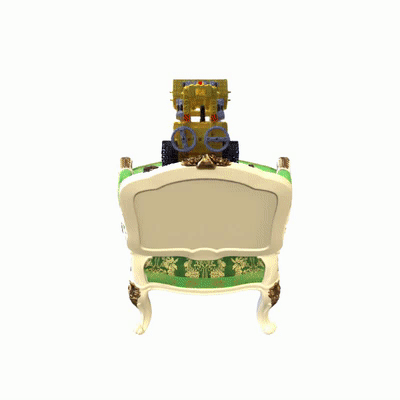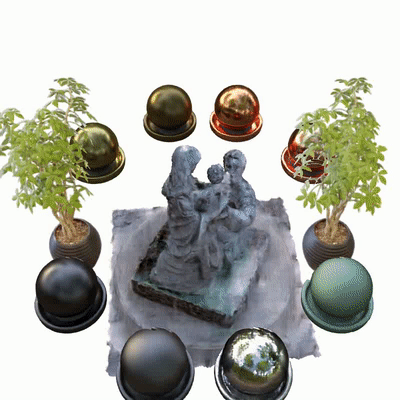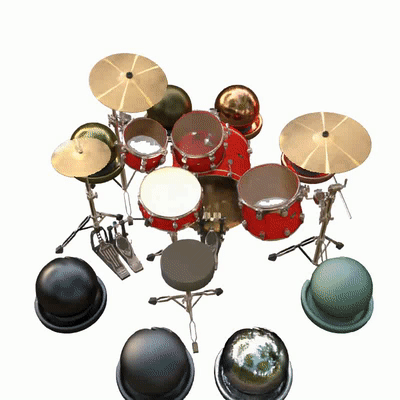This repository contains the official implementation for the paper: Frequency-Modulated Point Cloud Rendering with Easy Editing (CVPR 2023 Highlight).
Full code, configs and data will be available later.
conda create -n FreqPCR python=3.8
conda activate FreqPCR
conda install pytorch==1.8.0 torchvision==0.9.0 cudatoolkit=10.2 -c pytorch
pip install matplotlib
pip install opencv-python
pip install lpips
pip install git+https://github.com/francois-rozet/piqa
pip install tensorboard
pip install ConfigArgParse
pip install open3d
# PyTorch3D rasterization
python setup.py develop
Optionally, for real-time rendering, please run the following command:
# OpenGL, borrowed from NPBG
pip install \
Cython \
PyOpenGL \
PyOpenGL_accelerate
# need to install separately
pip install \
git+https://github.com/DmitryUlyanov/glumpy \
numpy-quaternion
# pycuda
git clone https://github.com/inducer/pycuda
cd pycuda
git submodule update --init
export PATH=$PATH:/usr/local/cuda/bin
./configure.py --cuda-enable-gl
python setup.py install
cd ..
The layout should look like this
FreqPCR
├── data
├── nerf_synthetic
├── TanksAndTemple
├── dtu
| ├── dtu_110
│ │ │── cams_1
│ │ │── image
│ │ │── mask
│ │ │── pc.ply
| ├── dtu_114
| ├── dtu_118
├── scannet
│ │ │──0000
| │ │ │──color_select
| │ │ │──pose_select
| │ │ |──intrinsic
| │ │ |──pc.ply
│ │ │──0043
│ │ │──0045
-
NeRF-Synthetic: Please download the dataset provided by NeRF and put the unpacked files in
data/nerf_synthetic. Since Point-NeRF provide an implementation of point cloud generation using MVSNet, we can run Point-NeRF and save the point clouds indata/pc/. You can also download raw point clouds from here. -
Tanks and Temples: Please download the dataset provided by NSVF and put the unpacked files in
data/TanksAndTemple. To generate point clouds, run Point-NeRF and save the point clouds indata/pc/. -
DTU: Please download images and masks from IDR and camera parameters from PatchmatchNet. We use the point clouds provided by NPBG++.
-
ScanNet: Please download data from ScanNet and run
select_scan.pyto select the frames. We use the provided depth map to generate point clouds. Forscene0043_00, the frames after 1000 are ignored because the camera parameters are-inf.
We experiment on a single NVIDIA GeForce RTX 3090 (24G), if your GPU memory is not enough, you can set the batch_size to 1 or reduce the train_size.
python pc_opt.py --config=configs/pc_opt/nerf_hotdog.txt
The optimized point cloud will be saved in logs_pc_opt/
python run_rasterize.py --config=configs/render/nerf_hotdog.txt
The point index and depth buffers will be saved in data/fragments.
python train.py --config=configs/render/nerf_hotdog.txt
The results will be saved in logs/. You can also run tensorboard to monitor training and testing.
python inference_gl.py --config=configs/render/nerf_hotdog.txt
TODO
- This project builds on our previous work RadianceMapping.
- The code of rasterization borrows a lot from PyTorch3D and NPBG.
If you find our work useful in your research, please consider citing:
@article{zhang2023frequency,
title={Frequency-Modulated Point Cloud Rendering with Easy Editing},
author={Zhang, Yi and Huang, Xiaoyang and Ni, Bingbing and Li, Teng and Zhang, Wenjun},
journal={arXiv preprint arXiv:2303.07596},
year={2023}
}



